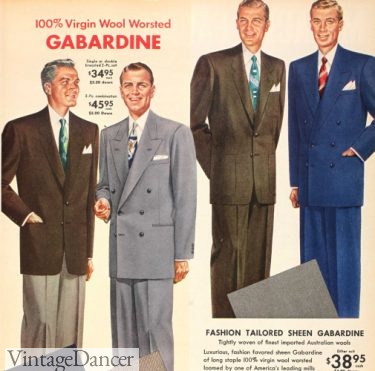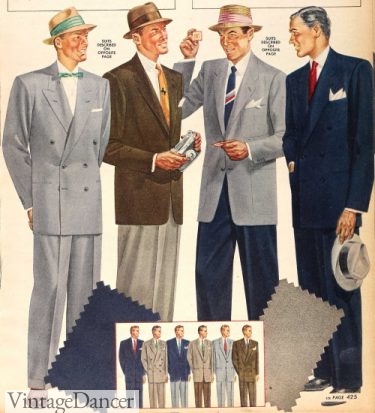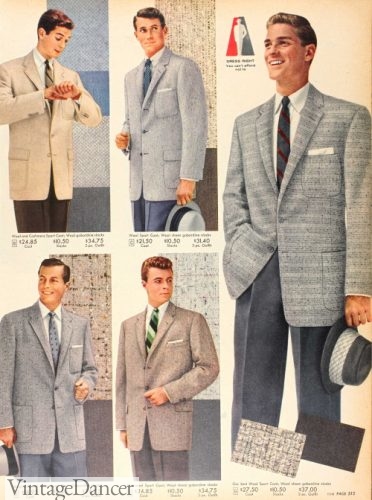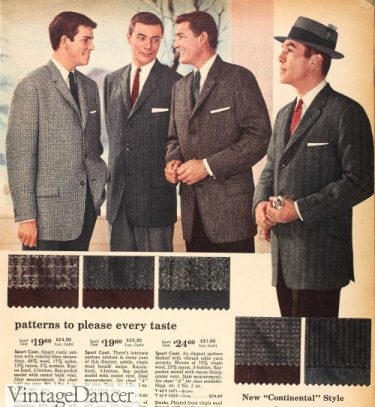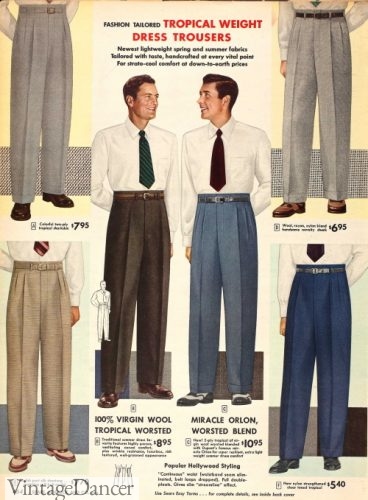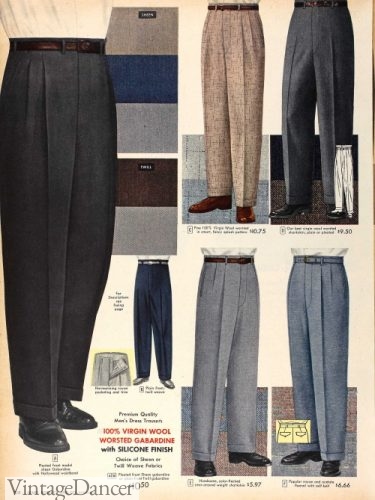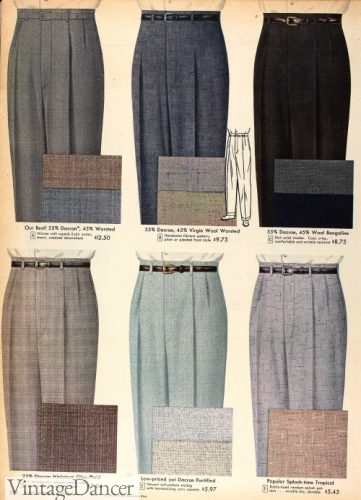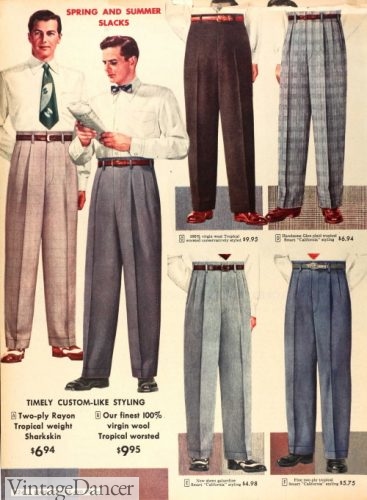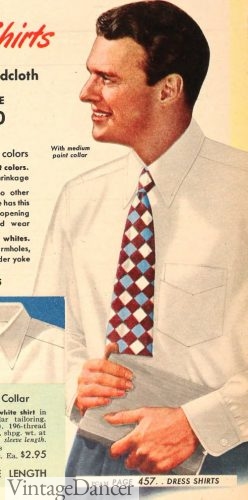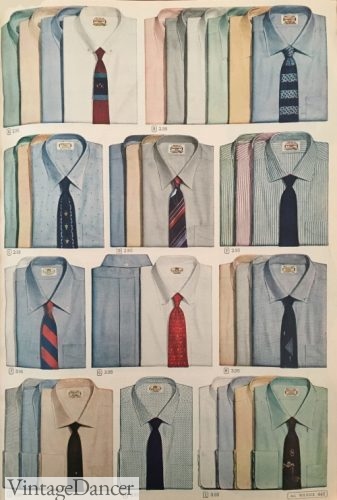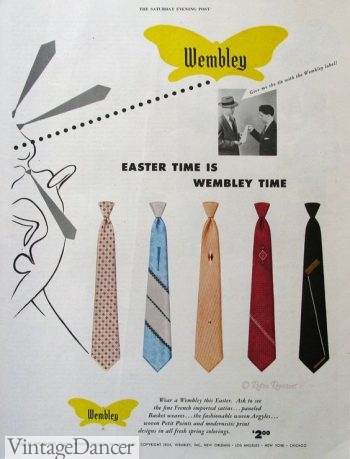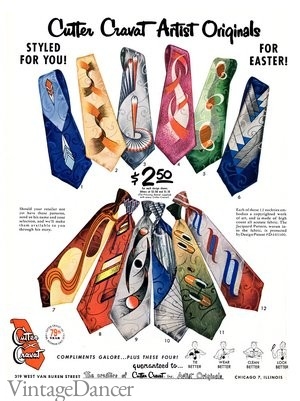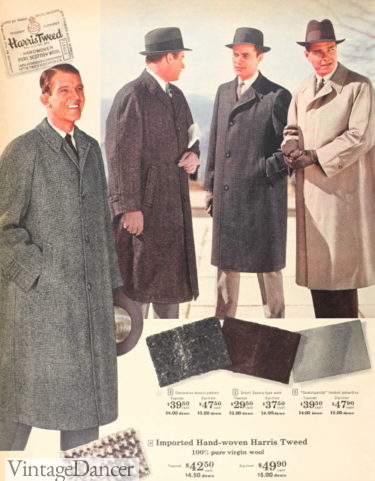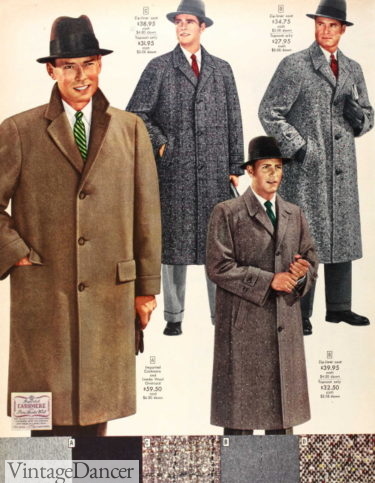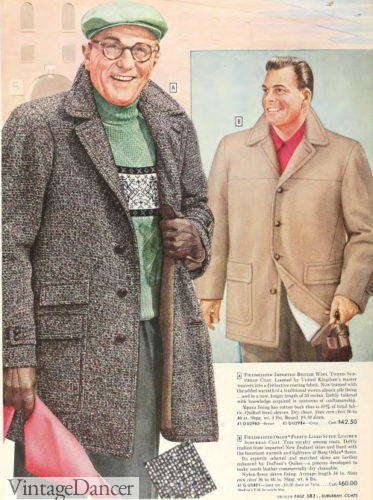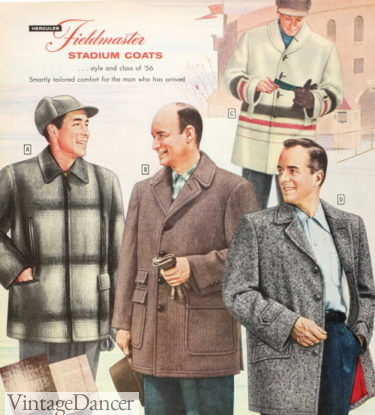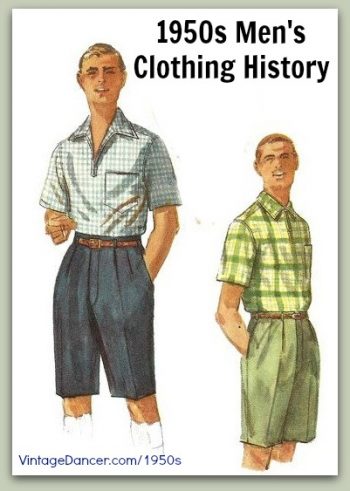In the 1950s, men’s fashion experienced a new paradigm shift. As always it was inspired by the youth, but even more so inspired by American casualness. Across the pond, all eyes were looking at American men for clothing designs that embraced the 4 C’s: color, comfort, correctness, and casualness. Color at first was conservative, echoing the insecure and untrustworthy nature of world politics. The Korean War and the McCarthy investigations made Americans shrink back from the dramatic late 1940s fashion into an understated natural look in the early 1950s. The “man in the grey flannel suit” emerged as both conservative and forward thinking.
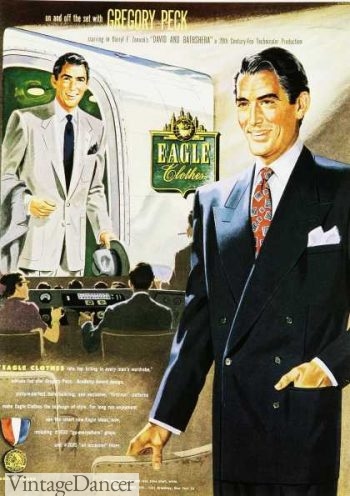
1950s men’s summer suits (Gregory Peck)
At the office, his clothes were narrower, straighter, and less fussy. Grey was the only color necessary in his wardrobe, with subtle shades of brown or blue for those daring to stand out. However, he wasn’t always dressed dull. For sportswear, pastels were out and big bold colors, heavy textures, and large patterns were in. They called this “peacock” fashion, and by the mid ’50s (when political unease subsided), color, print, texture, and design splashed onto the scene, growing bolder by the year.
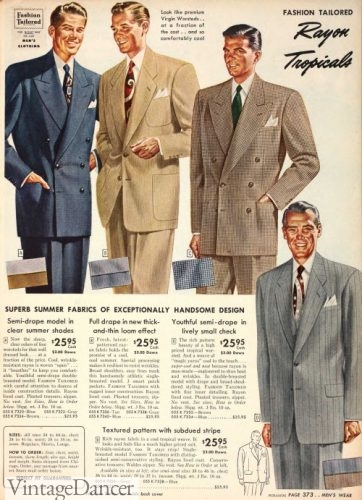
1951 men’s tropical weight Dacron and Wool suits
The new silhouette was called the Mr. T look. Hat brims narrowed and the crowns shortened. Shoulder pads were removed in favor a natural shoulder shape. Pants lost their pleats and in many cases belt loops, too. The newest feature was fabrics with texture. Usually heavy textured fabrics like tweed were reserved for sportswear, but in the 1950s nearly all fabrics, business or sport, had a texture to them. Tweed, like weaves, corduroy, wool pile, blanket cloth, etc, was a part of all clothing styles.
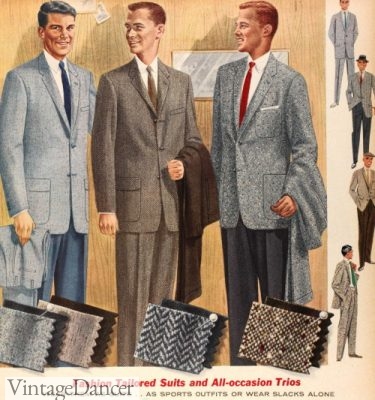
1957 men’s tweed suits and sport coats
Manufacturing methods and new synthetic fibers that were developed during WWII dramatically reduced the price of clothing and increased their durability. Men could buy more clothes for less money and afford to keep up with changing fashions. Improvements in public heating and cooling also changed the need for men to dress in extreme layers. Clothing could be lighter, while wash and wear was practical and better looking than previous decades. Housewives appreciated these new easy fabrics, and men appreciated the economical savings.
The blending of dress and casual became more and more blurred. Now men spent just as much time, if not more, in casual clothes after work and on the weekends than they did at the office. Labor workers changed into comfort clothes at the end of the work day, making work-wear disappear from public street view.
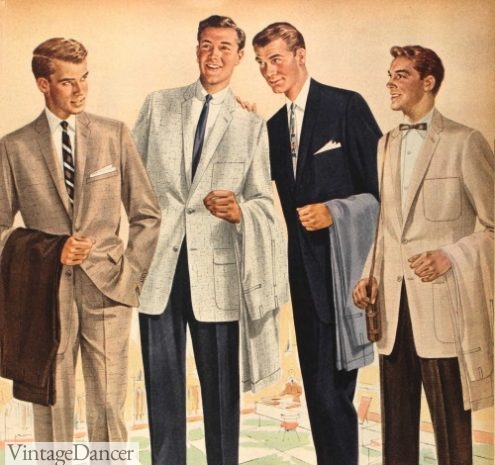
1958 men’s sport coats- mix and match trousers and jackets
Casual clothing in the 1950s meant a large patterned sport coat, as light weight as possible, paired with a bright colored shirt, and plain trousers or the new fad for knee length shorts in summer.
Up to this point, this doesn’t sound like the iconic 1950s men’s fashion with the Hawaiian shirts and leather jackets worn by the greasers we have come to know well today. They certainly had their place, especially in the teen or youth “Rock n’ Roll” culture, but outside this sub demographic, men 20 years old and up lived in an entirely different fashion culture. The rest of this series on 1950s men’s fashion will focus on these men, the bulk of society, who lived middle class lives in the suburban sprawl or the big city life.
1950s Men’s Fashion Suits
In the 1940s, the suit jacket had broad, padded shoulders, a nipped in waist, and wide lapels. The 1948 new look removed shoulder pads and dropped straight to the hip, hitting around mid-thigh. Lapels were soft, rolled and narrow. Most suits were single-breasted with long, wide lapels, and the suit fastened up the front with two or three buttons sitting low, exposing a long necktie and usually no waistcoat. Sometimes, there were two welt pockets. The breast pocket held a white handkerchief.
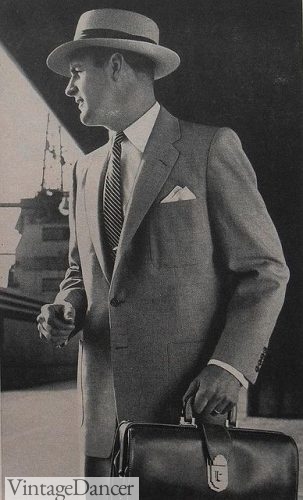
1950 Men’s Suit
In the ‘50s, men were usually the sole breadwinners, and serious heads of the household. Business dress reflected this role. Suits were somber, conservative, and mature looking. Men heading off to office work looked totally anonymous, blending in with everyone else.
This revised late 40s fashion was called the Mr. T look. The suit was now a shapeless tube with natural shoulders, marrow lapels, and straight hanging lines like those of the 1900s. The fit was loose and free, a welcome change from the tailored fashions of the previous 40 years.
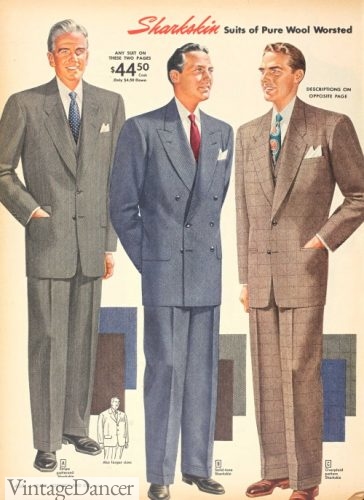
1951 men’s sharkskin suits
This “man in the grey flannel suit” (1955 novel) came directly from Ivy League college students (surprising? I thought so). On campus, students dressed down in dirty white nubuck shoes with thick red rubber soles, chino pants, and a button down shirt. When they graduated they attempted to dress more conservatively with a “plain gray flannel three piece, narrow shouldered sack suit, loose at the waist, with long jacket” (Fashion: Mirror of History).
“The man in the gray flannel suit came to represent all that was perceived to be wrong with American business- the conformity, the stodginess, the lack of true creativity, the unquestioning obedience to executive authority.” Esquire, June 1986 “Required Reading” by Bob Greene.
For the men who wore grey suits is wasn’t seen as oppressive but successful. Success at getting into the cooperate world, success living a good life and achieving the American dream, that so many men before could not accomplish.
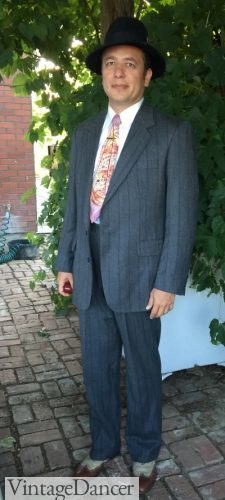
Oscar’s Vintage 1950s Grey Striped Suit
Teddy Boys in London copied the formal Edwardian look with striped pants, frock coats, rolled umbrellas, and neckties. American men thought that look was too formal and instead opted for the loose sack suit, which was also popular at the turn of the century among businessmen.
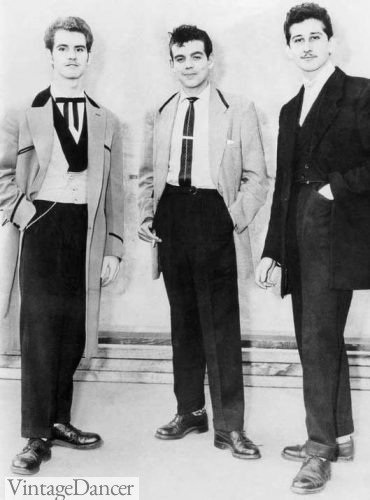
Teddy Boys dressed in Edwardian style clothing
A white shirt with button down collar narrowed to a straight point, a narrow tie (3.5 inches) of regimental stripe, and heavy Oxford shoes completed the look. For Ivy league kids (e.g. wealthy youth), the look was a tongue in cheek insult to traditional business clothes, but paid tribute to the middle classes who quickly adopted the new look, and it was a new freedom to dress more comfortably while maintaining a respectable social status.
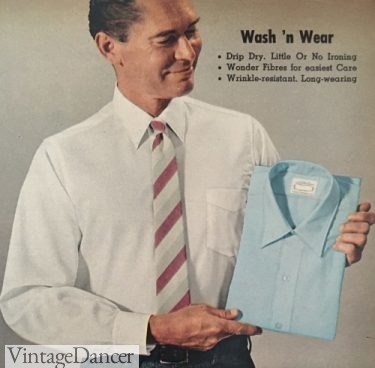
1958 white or blue, limited colors in the late 1950s
Business suits were traditionally made from wool, but in the ‘50s they started to be mixed or made wholly, from synthetic materials like rayon, nylon, acrylic, and polyester with branded names Dacron, Orlon, and Arnel. This made suiting much lighter, wrinkle resistant and easier to clean. Wool flannel, gaberdine, silk and sharkskin were other common fabrics with natural fibers.
Weaving techniques also developed various thicknesses and textures of suiting. Linen, nubby-silk, tweed, seersucker, and corduroy looking fabrics were made in the new weaves with accents of sparkle, coil, crimped or clear threads. Take a close look at any mid to late 1950s suiting and you will be amazed the complexity of the weave.
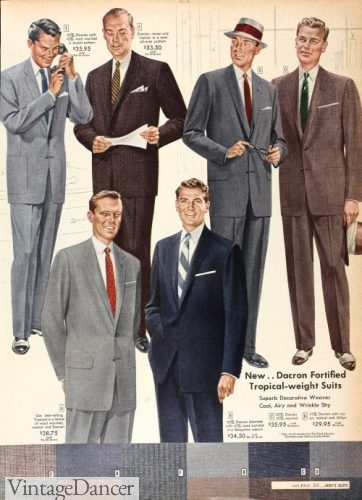
1957 Dacron blend suits
Grey was the most worn color in the early to mid 1950s but black, brown, and navy blue were also options. After 1955 colors lightened up, especially in summer when cream, light blue, tan, and silver grey were made in textured “tropical weight” fabrics such as linen, seersucker, and synthetic blends.
- 1953 men’s Gabardine suits
- 1954 summer suits and sport coats
New fabrics along with a new style called the “Continental look” took inspired from post-war Italian suiting after 1958. The suit took on some shaping again with natural shoulders, cutaway front, high-cut arm holes, angled pockets, peaked lapels, and cuffed sleeves. Trousers too were pleated and tapered in to the break.
There were many American experiments with Continental suits including one to three button coats, double-breasted coats, very narrow lapels and bland coloring, again. This look would carry well into the 1960s and continued to slim down.
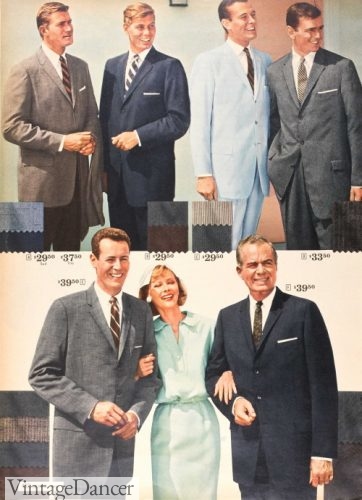
1959 men’s winter suits in the new Continental shapes
Read about 1950s Men’s Tuxedos and wedding attire.

Early 50s ballgown and white jacket tuxedo
1950s Sport Coats
An alternative to the 2 piece matching business suit was a nice sport coat with complementary, but usually not matching, pants. This very casual style was not welcome at all businesses, but for many it was acceptable and even a preferred fashion. The sport coat allowed the wearer to dress for work or leisure without needing to change. Patterns were big and bold for leisure wear, but were more conservative at the office.
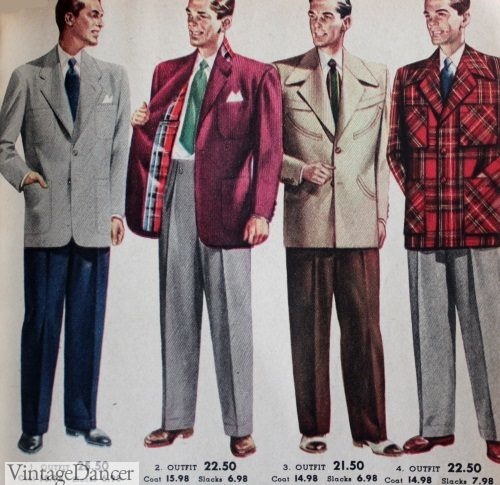
1951 Mens sport coats plaid with plaid linings were very common.
Grey, brown or dark blue tweed, shadow plaid, or large windowpane checks paired over smooth finished solid color pants in the same colorway. Brown with brown, grey with grey, etc. Some mixing such as blue with grey or any color with white was also acceptable. Coat colors in the early 50s were very bright- burgundy red, emerald green, teal blue, camel and ochre while slacks were neutral.
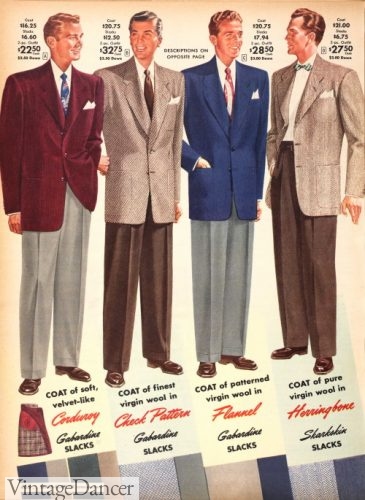
1951 plain sport coats or mix and match suits
In the middle to late years sport coats turned away from shocking colors and embraced the new textured fabrics. Small tweeds, checks, subtle plaids with contrasting threads weaves were offered in a muted color palate of greys, creams, tans and deep blues. It was fairly common to sell a man a suit or sport coat with several pairs of slacks in matching and coordinating colors.
- 1957 summer sportscoats- lighter colors and more texture
- 1959 winter sport coats in the Continental cut
A dress shirt, tie, dress shoes, and hat kept the look on the business side. In the heat of summer some men began to wear long tailored Bermuda shorts with sport coats. They were seen on city streets, restaurants, bars and some offices who permitted them. They were by no means very popular and once air conditioning was installed in buildings the need was limited.
As the decade progressed to the even more colorful late ’50s and ’60s, the acceptable colors and patterns for business expanded. We will look at sport coats in more detail in the next 1950s men’s fashion: casual clothing article.
Linen (and sometimes seersucker) provided enough texture and used lighter materials for the hot summer months. The “palm beach look” for day or evening was either a solid navy or pure white jacket over white pants.
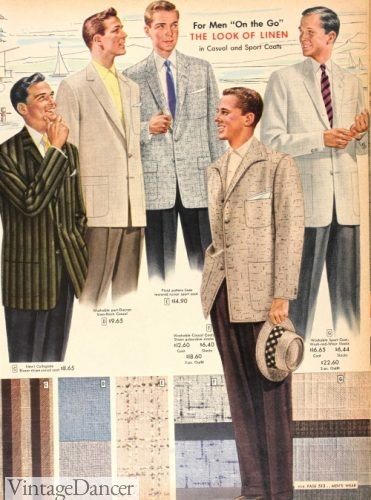
1957 linen-look men’s summer sport coats and striped boating blazer
Shop 1950s style suits and sport coats.
1950s Men’s Dress Pants
Pants, slacks or trousers were still moderately wide-legged at the beginning of the ’50s, but they quickly narrowed to 17.5 inches wide at the hem. They were worn at the waist, higher up than men are used to now. Pleats were going out of style. Flat fronts created a smoother, leaner look with a sharp crease down the center.
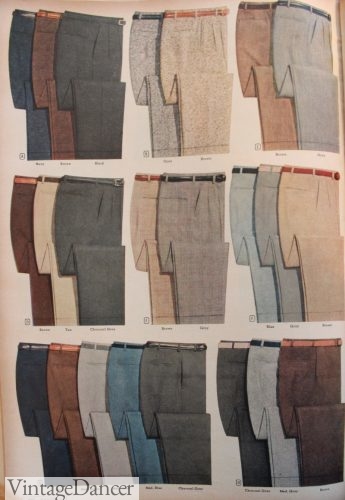
1955 Men’s Pants- a multitude of colors
Pant cuffs were no longer necessary, and many chose a plain hem instead. Since suspenders were on the decline in the ‘50s, suit pants became more fitted at the waist to stay up by themselves. Thin belts were common, but it was becoming more common to have self belts or continuous waist bands called “Hollywood waist.” The waistband was eliminated and belt loops dropped an in or two. The look was copied from men’s western pants, some with belt backs for a better fit.
- 1953 men’s dress slacks with Hollywood waistband and belts
- 1957 mens slacks with optional Hollywood waist
Later in the decade, suits became slightly slimmer in the jacket and pants, and lapels also became thinner. Colors expanded out of just grey and into shades of blues and browns. Texture also merged into suit fabrics with tweeds like grains, plaids, large checks and nubby wool blends but in smaller and muted patterns.
- 1957 summer weight dress pants
- 1952 mens dress pants

1950 Hollywood waist pants
Shop 1950s classic men’s pants
1950s Men’s Dress Shirts and Ties
In the early years, men’s dress shirts were dull and plain, just like the grey flannel suits. White, blue, light pink, mustard yellow, light green, light grey colors in smooth finishes complemented the suits. They fit rather wide and baggy (no modern trim fits yet) with a single cuff. Cufflinks were optional, but generally too fussy for this simple look. Most men’s dress shirts had a single breast pocket.
- 1952 men’s long point collar dress shirt and diamond tie
- 1956 Muted Tropical and Pastel Colors
The most popular shirt collars started out as straight pointed collars with or without buttons. As tie widths and knot shapes moved from narrow to wide to ultra skinny over the decade, so too did the collars. A straight spread collar accommodated most of the 1950s ties that had a wide tie knot. Narrow straight collars went with standard 3 inch or ultra skinny 2 inch ties.
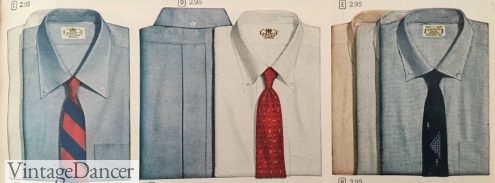
1956 men’s dress shirts with button down point and spread collars
There were also a few years when the round collar or “club” collar tie came back in fashion from the turn of the century. Collar pins also came back in style for more conservative dressers and added a nice upscale touch to point collars. Almost all collars shortened up during the decade. Most of today’s men’s shirts resemble those from the 1950s.
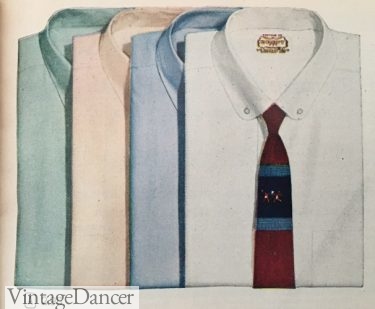
1956 button down club collars
Read more about men’s 1950s dress shirts.
Neckties and bow ties both narrowed and lengthened in the 1950s from the extreme wide and short tie of the 1940s. Designers also dumped the hand-painted novelty designs in favor of traditional stripes and textured solids. It made sense, then, that silk and shantung were perfect fabrics for men of this era.
Some novelty themes did remain common – wine grapes, wine glasses, historical statues, graduated stripes, swirls, geometric art, modern art, and hobby motifs introduced some patterns to otherwise plain ties. Big patterns were part of the early ’50s and small hints of design made up the remainder of the 1950s.
The 2 inch skinny knit/crochet tie was worn across college campuses both in solids and wide stripes. Learn more about men’s neckties.
- 1954 Mens Skinny Ties
- Geo Print Men’s Ties
1950s Men’s Dress Shoes
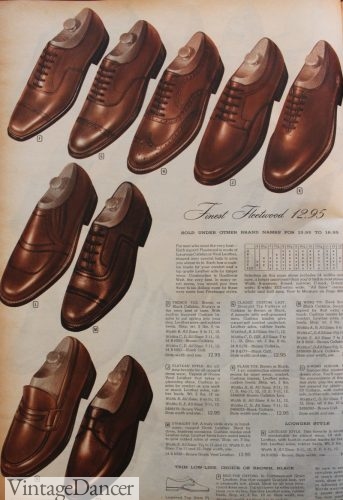
1955 Men’s Business Shoes
Conservative dress for men meant a change for men’s shoes, albeit a small one. Chunky sole shoes popular with young men were too bulky for the new slim look. Dress shoes slimmed down both in sole thickness and in shape. Toes returned to an almond shape, decorations were minimal, and colors limited to mostly brown and some black. The two tone shoes of the 1930s and 1940s were still popular, but only for sportswear. Men’s business dress required simple low heeled Oxfords or slip in shoes.
Oxfords could have cap toes, moccasin vamps or plain tops. Slip in styles mimicked the more casual penny loafer with or without tassels.
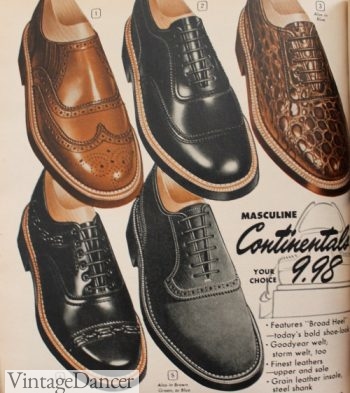
1950s Men’s Shoes
With sport coats, men’s shoes had more freedom. More colors such as grey, dark brown and even blue suede appeared along with two tone shoes. Shoes had textures, too, just like coat fabrics. Embossed leather, weaves, rough suede, and detailed brogue were common. Read about and shop for 1950s men’s shoe styles.
Socks that remained hidden under suit pants were the one area that had some personality in business dress. Argyle socks were very popular. Geometric designs on the ankles were also common, as well as plain ribbed socks in colors that matched suits. Looking at men’s business sock choices today, we can see very little has changed since the 1950s.
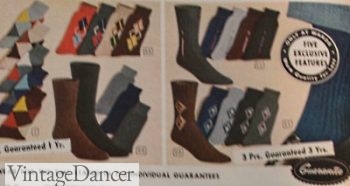
1959 Men’s Socks
1950s Men’s Overcoats
Thanks to improvements in heating and cooling in public spaces, homes, and cars as well as more and more men driving instead of walking to work, the need for heavy overcoats disappeared. Outerwear was now another fashion accessory — something with personality, style and design all on its own. They also became lighter with a thinner (or no) lining needed to stay warm for the short distances to and from the car.
- 1959 overcoats
- 1956 overcoats
For business attire, a knee length overcoat, topcoat, or rain coat provided all the protection a man needed. Most of the 1940s coat styles remained in style through the mid 50s. Following the major fashion trends of the 1950s, men’s overcoats were also textured or had small by notable patterns. These bolder looking coats added the missing personality from the conservative grey flannel suit look.
Overcoats had high military collars, straight hanging lines, slanted flap pockets, cuffed sleeves and horizontal peaked lapels. In the early years, the raglan sleeve coat helped emphasize the natural sloped shoulder and reduced bulk up top. The shawl collar also experience a revival for a softer look.
Silk was the biggest trend in the early 50s for those who could afford it. Donegal tweed with flecks of bright colors was the next best option and more easily afforded.
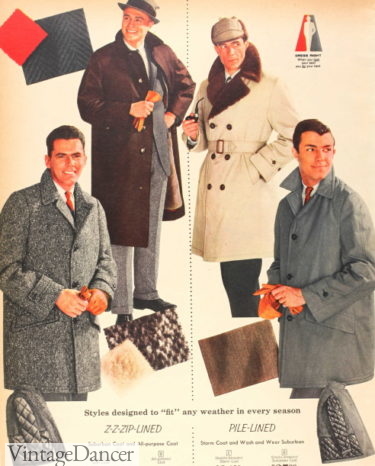
1959 suburban coats, trench coat, rain coat
Other coat styles could be worn with suits as well. The short overcoat called suburban coat was fingertip length with two or three large pockets. Tweed in grey shades were very popular as was camel and a return of the blanket cloth.
- 1956 suburban coats- grey tweed and camel tan
- 1956 suburban coats or stadium coats- blanket cloth, plaid wool, tweeds
A similar style for mid winter was the duffle coat or “duffer.” It had toggle buttons from belt to neck, a high round collar, patch pockets and several lines around the hem or “railroad stitching.” With a zip out lining they were the perfect in-between season coat between long overcoat and short jacket.
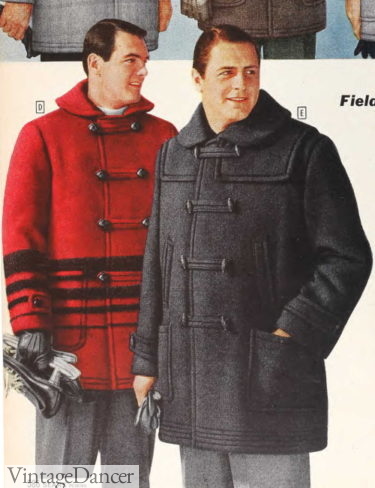
1957 men’s toggle coat
For men traveling by motorcycle or topless sports cars, a leather or suede bomber jacket was the best for wind protection. Teens were not the only ones to dress like greasers!
Shop 1950s style men’s coats and jackets.
1950s Men’s Hats
Author Neil Steinberg of Hatless Jack argues in his fascinating book that John F. Kennedy’s refusal to wear hats led the revolution for men to go hatless. The truth is (and Neil points this out as well) that the hatless trend was already well establish by the 1950s. Only half of the men were still wearing hats on a daily basis. Most of the men who wore them were middle aged and older. They grew up wearing hats, and had no intention to stop. The younger generation saw no need for them. They spent a great amount of time and effort grooming their hair into a pompadour, so why ruin it with a hat?
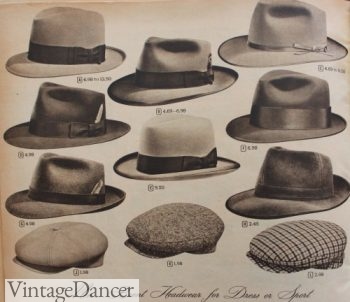
1955 Men’s Business and Sport Hats
For the hat wearing men of the 1950s, a fedora was still the preferred hat to wear with business suits. The 1950s version, also called a Tremont, had a slightly shorter crown and narrower brim than the wide 1940s style. They almost all came with a flat grosgrain bow (usually black, but they could also be matching) and about half had a small feather peeking out from the behind the bow. Crowns had a pinch front and a tapered angle to the back. Brims were mostly flat with a slight turn up at the back.
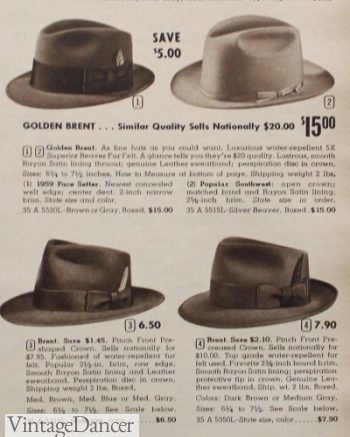
1959 Mens Fedora Hats
Other common hat styles were the center dent fedora, western or cowboy hat, homburg, and pork pie. In summer, these same models came in a fine woven straw plus a few other shapes that we will get into next time. Read more about and shop 1950s men’s hat styles here.
1950s Men’s Casual Fashion
Ready for work in the business world, a well dressed man was tall, thin, understated and yet had a respectable authority. His business fashion contrasted heavily with his leisure wear. Both styles played a significant role in men’s 1950s fashion history.
Read Part 2: Casual Men’s 1950s Fashions and see the other side of the fashion story
Debbie Sessions has been teaching fashion history and helping people dress for vintage themed events since 2009. She has turned a hobby into VintageDancer.com with hundreds of well researched articles and hand picked links to vintage inspired clothing online. She aims to make dressing accurately (or not) an affordable option for all. Oh, and she dances too.
